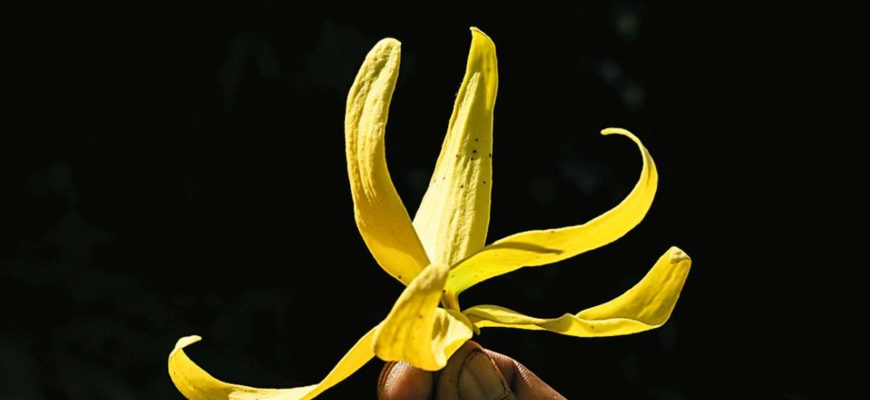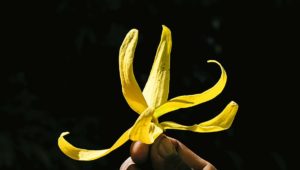

COMPLETE YLANG-YLANG
Cananga odorata
DESCRIPTION

Ylang-ylang (Cananga odorata) is a tree of the Annonaceae family, native to South-East Asia. Its Malay name means “flower of flowers”.
ADVICE
DO NOT USE IN
– pregnant or breast-feeding women,
– children under the age of six years,
– persons allergic to one of the components (benzyl benzoate, citral, eugenol, farsenol, geraniol, linalool, benzyl salicylate),
– subjects with asthma without the advice of an allergologist before the first use.
RECIPES
Relaxation
There is nothing like taking a bath into which you have poured 10 drops of essential oil of ylang-ylang mixed with a cap-full of neutral base or powdered milk, to recapture your elusive optimism.
Abdominal pain
5 drops of EO of basil, 5 drops of EO of ylang-ylang, 10 drops of neutral CO. Mix the oils and massage your stomach. Repeat once during the day, for several days if necessary.
Hair lustre
Add 1 drop of ylang-ylang to your usual dose of shampoo and leave on the hair for one minute.
If your hair is dry, add 1 drop of essential oil of clary sage.
Awakening of the senses, reduced libido (man or woman)
Rub the lower back with 10 drops of essential oil of ylang-ylang diluted in 30 drops of sweet almond carrier oil. Next, massage the entire body and do not forget to diffuse a few drops of essential oil in the bedroom.
Beauty oil for dry and devitalised skin
10 drops of EO of carrot, 5 drops of EO of rose geranium, 5 drops of EO of ylang-ylang, 20 ml of rose hip carrier oil. Massage your face thoroughly for three minutes, morning and evening.
You can also add 5 drops of essential oil of ylang-ylang to your dose of day cream.

Its Malay name means “flower of flowers”. Its bark is grey; its bright green persistent leaves are arranged regularly along its long branches. The bunches of yellow flowers exhale a penetrating odour. Wild trees can grow to a height of twenty metres, but when cultivated, it is restricted to two or three metres to facilitate harvesting, which starts when the petals wither and their reddish base appears.
Just as the orang-utan, its neighbour in the animal world embodies the brutal force of the male, ylang-ylang, thanks to its flowers, is the odor di femina of the plant kingdom. It is reminiscent of Gauguin’s vahinés, the fantasy of Europeans and dream of the southern sea navigators. Aware of the effect of the “flower of flowers” on men, Indonesian women macerate it in coconut oil, which they then apply to their dark hair. They also spread ylang-ylang onto the bride and bridegroom’s bed to ensure that the wedding night is a success. Our perfumers have used this exotic and erotic fragrance extensively, from “Bois des Îles” by Coco Chanel (1926) to “Joy” by Jean Patou (1930). In traditional tropical medicine, ylang-ylang is used, amongst others, to treat malaria.
CULTIVATION AND PRODUCTION
Ylang-ylang grows wild in hot and moist forests, in India, Indonesia, Malaysia and the Philippines. The trees flower year-round, though the flowers are more intense during the monsoon season. They are cultivated in the Pacific isles that offer the same climatic conditions. Madagascar, the Seychelles and the Comoros are producer countries. France produces one of the best available qualities on the Reunion island, where the tree was introduced in 1880. Nowadays, however, Reunion production has petered out.
FRAGRANCE
The odour of ylang-ylang is heady, suave and sweet.
EXTRACTION AND YIELD
The steam distillation of fresh ylang-ylang flowers is a long and delicate process (ten to twenty hours). Performed in a fractionated manner, it provides five fractions corresponding to distinct qualities of essential oil based on essence density: extra-superior, extra, premium, second and third. The extra-superior, extra and premium fractions are reserved for the luxury perfume industry, while second and third qualities are used for cosmetics, soaps and detergents. Aromatherapy uses a different quality of essential oil, called “complete”, obtained by continuous distillation for more than ten hours. The essential oil yield of ylang-ylang is of 1.8% to 2.4%, i.e. eighteen hundred grams to two kilograms of essential oil from hundred kilograms of flowers.
CHEMICAL FORMULA
The main active constituents of essential oil of Cananga odorata are monoterpene alcohols (linalool), esters (benzyl and geranyl acetates) and phenols.
MAIN INDICATIONS
This essential oil is excellent for combating physical, intellectual and sexual fatigue. It is perfectly indicated in cases of stress, anxiety or sleeplessness thanks to its soothing properties. It is also a good anti-inflammatory and anti-rheumatism. It revitalises the hair and regenerates tired skin by re-balancing sebum secretion.


Leave a Comment